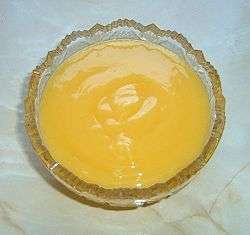Fruit curd
|
Homemade lemon curd | |
| Type | Spread |
|---|---|
| Course | Dessert |
| Main ingredients | Egg yolks, sugar, fruit juice and zest (lemons, limes, oranges or raspberries) |
|
| |
Fruit curd is a dessert spread and topping usually made with citrus fruit, such as lemon,[1] lime,[2] orange[3] or tangerine.[4] Other flavor variations include passion fruit,[5] mango,[6] and berries such as raspberries,[7] cranberries or blackberries.[8] The basic ingredients are beaten egg yolks, sugar, fruit juice and zest which are gently cooked together until thick and then allowed to cool, forming a soft, smooth, intensely flavored spread. Some recipes also include egg whites and/or butter.[9]
In late 19th and early 20th century England, home-made lemon curd was traditionally served with bread or scones at afternoon tea as an alternative to jam, and as a filling for cakes, small pastries and tarts.[10] Homemade lemon curd was usually made in relatively small amounts as it did not keep as well as jam. In more modern times, larger quantities became possible because of the use of refrigeration. Commercially manufactured curds often contain additional preservatives and thickening agents.[11]
Contemporary commercially made curds remain a popular spread for bread, scones, toast, waffles, crumpets, pancakes, cheesecake [12] or muffins. They can also be used as a flavoring for desserts or yogurt. Lemon-meringue pie, made with lemon curd and topped with meringue, has been a popular dessert in Britain and the United States since the nineteenth century.[10] Lemon curd can also have whipped cream folded into it for such uses as filling cream puffs.[13]
Curds differ from pie fillings or custards in that they contain a higher proportion of juice and zest, which gives them a more intense flavor.[14] Also, curds containing butter have a smoother and creamier texture than both pie fillings and custards, which contain little or no butter and use cornstarch or flour for thickening. Additionally, unlike custards, curds are not usually eaten on their own.
See also
References
| Wikibooks Cookbook has a recipe/module on |
- ↑ "Lemon curd". BBC. Retrieved 2015-01-08.
- ↑ England, Kaia. "Fresh lime curd". BBC. Retrieved 2015-01-08.
- ↑ Braker, Flo (September 1998). "Orange curd". Time Inc. Retrieved 2015-01-08.
- ↑ "Nectarine lime curd tart with a brown-sugar crust". Gourmet Magazine. June 1998. Retrieved 2008-09-02.
- ↑ "Passion-fruit meringue tart". Gourmet Magazine. June 2005. Retrieved 2008-09-02.
- ↑ "Mango curd". Gourmet Magazine. June 1998. Retrieved 2008-09-02.
- ↑ "Cake Talk: What the terms mean". The Joy of Cooking. The Seattle Times. 2005-06-29. Retrieved 2008-09-02.
- ↑ Lawson, Nigella (2001-11-14). How to be a Domestic Goddess, Cranberry curd. Hyperion Books. p. 343. ISBN 0-7868-6797-3. Retrieved 2008-09-02.
- ↑ Ramsay, Gordon (20 June 2007). "Lemon and Poppy Seed Scones with Homemade Lemon Curd". The Times.
- 1 2 D'Sa, Elaine M. (August 2004). "Preparing and Preserving Lemon Curd" (PDF). The University of Georgia. Retrieved 31 October 2016.
- ↑ "Lemon Curd: Nutrition Facts" (PDF). National Center for Home Food Preservation. 2004. Retrieved 2008-07-13.
- ↑ "Mango and Lemon Cheesecake". Food To Love. 2012. Retrieved 2016-02-23.
- ↑ Cream Puffs with Lemon-Cream Filling. bon appétit. April 2010. retrieved May7, 2015.
- ↑ Mariani, John F. (1999). Encyclopedia of American Food and Drink. New York: Lebhar-Friedman. p. 182.
